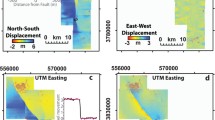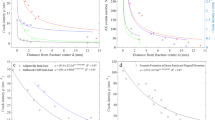Abstract
—The characteristics of slip and stress drop distributions accompanying earthquakes are explored from the perspective of fractional Brownian motion (fBm). Slip and stress drop distributions are assumed to be processes of fBm.The Hurst exponent (H), which reveals the roughness of a random process of fBm, is first estimated from ten inferred slip maps for six crustal earthquakes occurring in California. The relationships between the Hurst exponents with respect to static slip (H u ),stress (H τ ), static stress drop (H δσ ) and slip velocity (H ú ) are then established following Andrews (1980). They are found to be H δσ = H τ = H u -1 = H ú -0.5. Empirically, H u is recognized as being about 1 which, according to the theory of fBm, implies that the static slip distribution of an earthquake is just on the margin between being and not being self-similar, depending on the individual case. Cases where H u is less than 1 (i.e., self-similar) suggest that H δσ < 0(i.e., the distribution of static stress drop diverges), which is, in light of fBm, invalid. One possible explanation for this paradox is that H u is less than 1 in crustal earthquake phenomena only over a certain specific bandwidth of wavenumbers, or it could be that the relation H δσ = H u -1 is not valid, which implies that static stress drop in the wavenumber domain is not the product of stiffness and slip as described in Andrews (1980). It could be that some different physics apply over this particular bandwidth. In such cases, multi-fractals may be a better way to explore the characteristics of the Hurst exponents of slip. In general, static stress drop and stress distributions are more likely to be self-similar than static slip distribution. H u ≌ 1 and H δσ ≌ 0 are good first approxima tions for the slip and stress drop distributions. The spectrum of ground motion displacement falls off as ω-(Hδσ + 2) with H δσ ≌ 0, consistent with an ω-2 model of the earthquake source.
Similar content being viewed by others
Author information
Authors and Affiliations
Additional information
Received March 5, 1996, accepted January 18, 1997
Rights and permissions
About this article
Cite this article
Tsai , CC. Slip, Stress Drop and Ground Motion of Earthquakes: A View from the Perspective of Fractional Brownian Motion. Pure appl. geophys. 149, 689–706 (1997). https://doi.org/10.1007/s000240050047
Published:
Issue Date:
DOI: https://doi.org/10.1007/s000240050047




